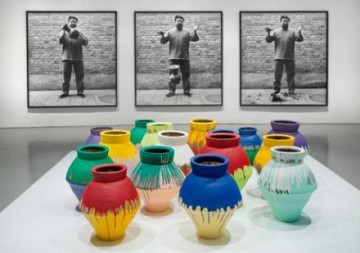
Originally published in the Marina Times San Francisco September 2014
If my art had nothing to do with people’s pain and sorrow, what is ‘art’ for? — Ai Weiwei
With Ai Weiwei’s arrest in a Beijing airport in 2011, questions arose. What could one artist do to be perceived as a threat to authorities? The Chinese government held him for 81 days, and he is currently unable to leave the country. Despite these obstacles, Ai has not been silenced.
His new work, @Large: Ai Weiwei on Alcatraz, opens on Sept. 27 and consists of seven site-specific sculpture, sound, and mixed media installations. It will occupy four locations on Alcatraz, spaces usually off limits to visitors on the tour, creating a new context for the famed federal penitentiary and its history. A team of art guides at each installation site will provide the viewer with additional understanding about the location’s history and the meanings suggested by Ai. It is hoped that this extra effort will encourage a dialogue about broader social issues related to freedom of expression and our own country’s prison culture.
Ai’s sculpture, photography, film, artwork, ceramics, performance art, and messages via social media are an idiosyncratic output that emphasizes power through loss. Undermining the original intent of an object or space creates a disturbance that promotes evolution. Dropping a Han Dynasty Urn from 1985, for example, is a series of photos showing the artist dropping and shattering the ancient vessels on a sidewalk. Subverting the original intent of an object transforms it into a talisman for change, a signpost pointing toward a kind of rebirth and departure from tradition. Remembrance, 2010, is a voice recording listing the names of over 5,000 students who died in collapsed, poorly constructed schoolhouses during the Sichuan earthquake. Stories taken from contemporary history mix with parts of China’s distant past along with remnants of temples, found objects, and relics from antiquity — a collective history reinvented into new narratives.
Ai’s sociopolitical art, cultural criticism, and human rights activism has made him a natural target for Chinese authorities that attempt to censor his output. Though he has never been to Alcatraz and cannot travel outside China, Ai developed these artworks in his Beijing studio with the support of San Francisco gallery owner and For-Site Foundation founder Cheryl Haines and an international team of collaborators from organizations, including Amnesty International and Human Rights Watch. For-Site Foundation, which seeks to bring art to public places, teamed with the National Park Service and the Golden Gate Parks Conservancy to bring the work to Alcatraz.
Far from discouraging his voice, Ai continually transforms his activism and adversity into more art. Political struggle is an aesthetic essential to his artistry. For Ai, art is also an opportunity to deconstruct society’s assumptions of value, mass production, information, and its impact on the human race. But it’s not enough to present new possibilities for self-awareness. Ai Weiwei encourages all of us to “… do one small thing every day to prove the existence of justice.”
@Large: Ai Weiwei on Alcatraz: Sept. 27–April 25, 2015. Daily, tickets $30–$37 at 415-981-7625, alcatrazcruises.com or Alcatraz Landing ticket office at Pier 33. Tickets include access to all Ai Weiwei installations and the award-winning Alcatraz audio tour. Exhibition organizers recommend allocating 3½ to 4 hours to experience both the @Large: Ai Weiwei on Alcatraz exhibition (minimum 90 minutes) and the Cellhouse Audio Tour (approximately 2 hours).